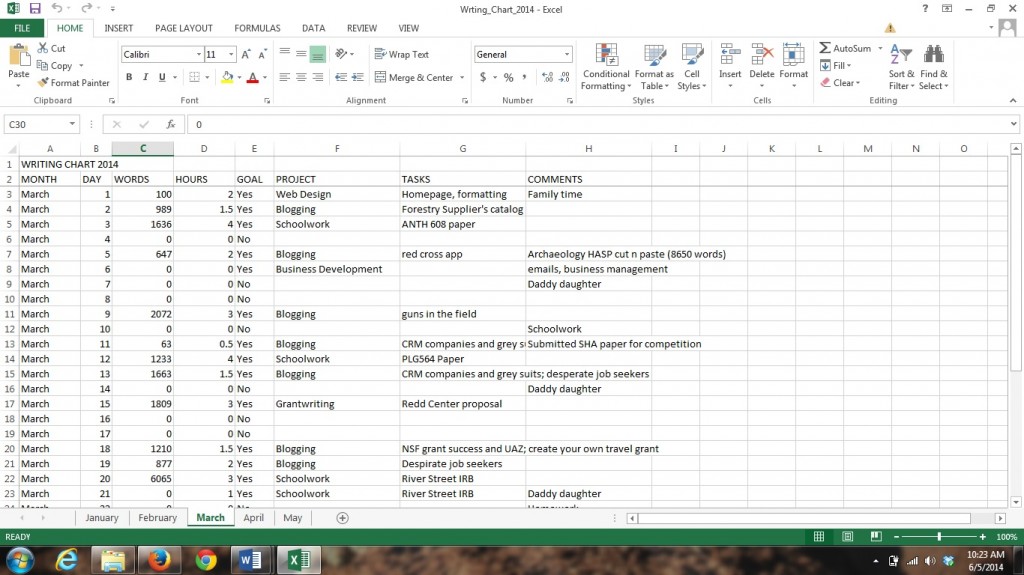 “This is some great stuff! There’s nothing like this out there. Are you willing to publish this as a book?”
“This is some great stuff! There’s nothing like this out there. Are you willing to publish this as a book?”
From what I’ve heard, this is the way my good friend Chris Webster who just got his book The Field Archaeologist’s Survival Guide published by Left Coast Press. It was launched at this year’s Society for American Archaeology conference and was very well received. Ever had anyone tell you about getting unemployment, how to maintain health insurance, and how to budget for the inevitable winter CRM archaeology layoff? Well Chris covers those topics and more in his book. It’s a true gem and an excellent resource for anyone thinking of becoming a cultural resource management archaeologist.
The book was built from blog posts. I’ll say that again: Chris got a book published based on a series of blog posts. Blogging is an excellent way to create content that can be added to class papers, professional presentations, theses/dissertations, and, now, entire books. There are dozens of non-archaeology bloggers that discuss the value of writing thematic blog posts and repurposing this content in order to create “products”, which, in the case of archaeologists, can be books and articles.
Since our industry is known for “feast or famine” and is in the midst of a general decline, maybe its time to look towards marketers and businesspeople to find a way to save the industry and/or further the careers of up-and-coming archaeologists.
In their best-selling business book “Content Rules: How to Create Killer Blogs, Podcasts, Videos, Ebooks, Webinars (and More) that Engage Customers and Ignite your Business”, Ann Handly and C.C. Chapman outline a publishing schedule that can easily be adapted for archaeologists that are interested in reaching communities and connecting with their peers within the field. They outline a specific strategy that has been proven to increase your blog’s traffic, interaction, and interconnectivity. The key to this strategy is maintaining a writing or publishing schedule.
Handly and Chapman are salespeople, not archaeologists. But, their tips are solid and I’ve been using an abbreviated version of their recommendations on this blog with some pretty good success. They recommend the following publishing schedule:
Daily—Daily social media updates (Twitter, LinkedIn, Facebook, Pinterest ect. [They recommend you don’t try to do all of them]). They suggest you talk about news and other blogs in your industry in addition to your own blog posts.
FYI: I use a free HootSuite account to schedule social media posts. It takes about 1-2 hours each week to skim archaeology and historic preservation-related articles and schedule posts that will be published throughout the week. This is much less grueling than trying to tweet throughout the day.
Weekly—Write blog posts (1-3/week), videos, slideshows, podcasts ect.
Monthly—Interview an expert, write a newsletter, create a Killer Post (1000-3000 words that shows your in-depth understanding of a topic), create a presentation, organize/attend a meet-up, and highlight a case-study or success story.
This can take many forms for archaeologists, but I think a monthly Killer Post is essential because if you wrote a 2,000-word killer each month for a year you’d have around 24,000 words of quality content. That’s a pretty good start to a book.
Quarterly—Create an eBook, video series, or webinar. These can all be created from your weekly and monthly content.
Bi-Annually—Host an event, workshop, executive round table, or create a “Best Practices Guide.”
As you can see, the idea is to organize your activities in such a manner that it can accumulate to the point where you can create a book or journal article. The goal is to use your blogging as a launch pad that furthers your archaeology writing and publishing, which in turn moves your career further down the line.
That all sounds like a lot of work, doesn’t it
Well, it is and it isn’t. All journeys begin with a single step.
“The man who moves a mountain begins by carrying away small stones.” Confucius, The Analects.
You will have to dedicate a fair amount of time toward furthering your writing, but becoming a better writer is one of the most useful things you can do to boost your archaeology career. According to a CRM PI and ACRA member, solid writing skills is the most sought-after abilities for cultural resource management company managers. Your writing skills and technical writing background can be the thing that makes the difference between getting hired as a field director and getting a job as a field tech. You may have a lot of projects on your CV, but what makes a company think you can write up their reports if you’ve never authored reports or journal articles? Just like I mentioned Projects are the new Resumes, a proven track record of authorship is your ladder to upper management.
Blogging is an excellent way to hone your writing skills. If you write posts in the way mentioned by Haney and Chapman, you’ll be well on the path to publishing white papers, eBooks, articles, and even books.
They key is staying on top of your game on a daily basis. “Writing your Journal Article in 12 Weeks” by Wendy Laura Belcher is another awesome reference that can help you get stuff published. Belcher talks about the process of turning a term paper or presentation paper into an article draft and getting it published. One of the most useful things she discusses is the creation of a daily writing journal.
The goal is to write, edit, and research a little every single day. A schedule also makes you aware of the total words you’ve written each month, which allows you to get an idea of how much you write on average and set personal goals. I’ve used Belcher’s writing schedule model to keep me motivated and writing regularly. I use a Microsoft Excel table to keep track of my progress (see the JPG below), but there are many different ways you can go with this depending on your ultimate goals.
No matter what you want to accomplish in archaeology, historic preservation, or heritage conservation, becoming a better and more prolific writer is absolutely essential. Nobody is born a writer because nobody is born knowing how to write or speak a language. Writing takes practice. Writing practice makes perfect; although, there is no such thing as a perfect writer. Creating and using a writing schedule is an excellent way to further your archaeology career. Start today!
Do you use a writing schedule? How’s it been working so far? Write a comment below or send me an email.
Check out Succinct Research’s most recent publication Blogging Archaeology. Full of amazing information about how blogging is revolutionizing archaeology publishing. For a limited time you can GRAB A COPY FOR FREE!!!! Click Here
 “Resume-Writing for Archaeologists” is now available on Amazon.com. Click Here and get detailed instructions on how you can land a job in CRM archaeology today!
“Resume-Writing for Archaeologists” is now available on Amazon.com. Click Here and get detailed instructions on how you can land a job in CRM archaeology today!
 Small Archaeology Project Management is now on the Kindle Store. Over 300 copies were sold in the first month! Click Here and see what the buzz is all about.
Small Archaeology Project Management is now on the Kindle Store. Over 300 copies were sold in the first month! Click Here and see what the buzz is all about.
Join the Succinct Research email list and receive additional information on the CRM and heritage conservation field.
Get killer information about the CRM archaeology industry and historic preservation.




